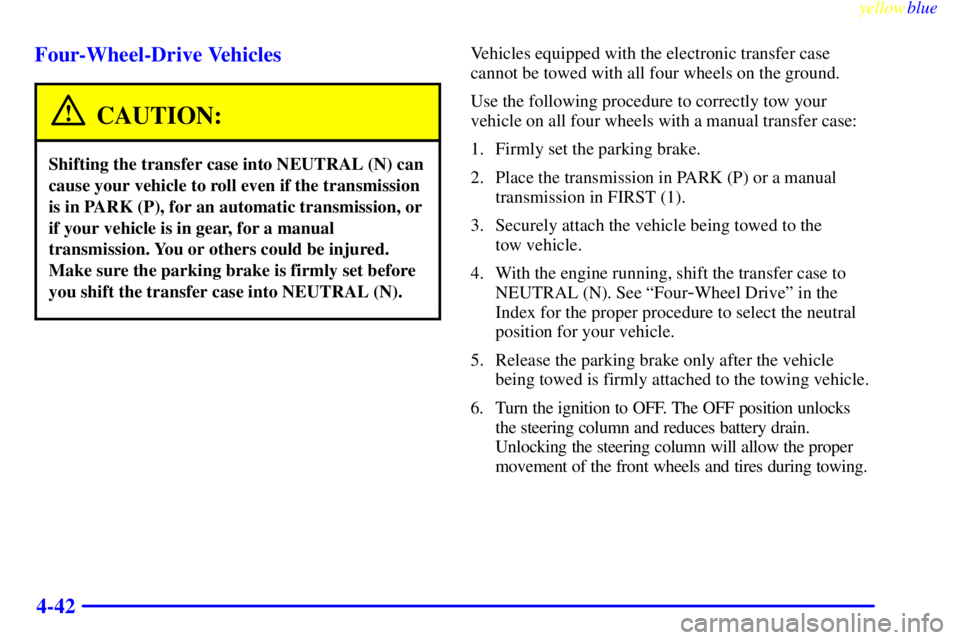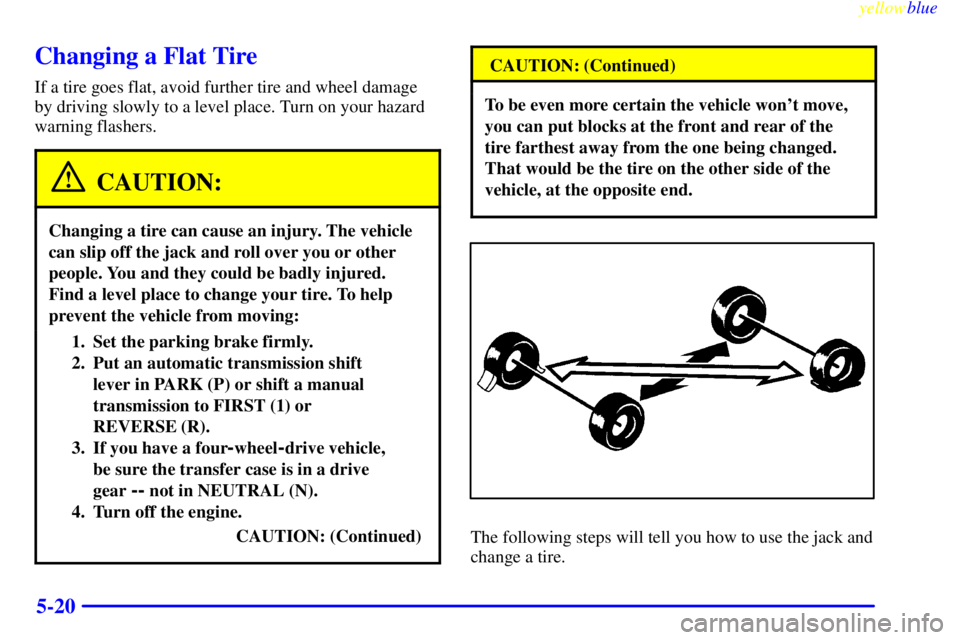Page 89 of 440
yellowblue
2-11
Ignition Positions
CAUTION:
Leaving children in a vehicle with the ignition
key is dangerous for many reasons. A child or
others could be injured or even killed. They could
operate power windows or other controls or even
make the vehicle move. Don't leave the keys in
the vehicle with children.
You can use your key to turn your ignition switch to
five different positions.ACCESSORY (A): ACCESSORY lets you use things
like the radio, power windows and the windshield
wipers when the engine is off. Push in the key and turn
it toward you. Your steering wheel will remain locked,
just as it was before you inserted the key.
LOCK (B): This position locks your ignition, steering
wheel and transmission. It's a theft
-deterrent feature.
You will only be able to remove your key when the
ignition is turned to LOCK.
Page 94 of 440

yellowblue
2-16
Automatic Transmission Operation
There are several different positions for your shift lever.
If your vehicle is equipped with an automatic
transmission, it features an electronic shift position
indicator within the instrument cluster. This display
must be powered any time the shift lever is capable of
being moved out of PARK (P). This means that if your
key is in OFF, rather than LOCK, there will be a small
current drain on your battery which could discharge
your battery over a period of time. If you have to leave
your key in the ignition in OFF for an extended period,
it is recommended that you disconnect the battery cable
from the battery to prevent discharging your battery.
PARK (P): This locks your rear wheels. It's the best
position to use when you start your engine because your
vehicle can't move easily.
CAUTION:
It is dangerous to get out of your vehicle if the
shift lever is not fully in PARK (P) with the
parking brake firmly set. Your vehicle can roll.
Don't leave your vehicle when the engine is
running unless you have to. If you have left the
engine running, the vehicle can move suddenly.
You or others could be injured. To be sure your
vehicle won't move, even when you're on fairly
level ground, always set your parking brake
and move the shift lever to PARK (P).
If you have four-wheel drive, your vehicle
will be free to roll
-- even if your shift lever
is in PARK (P)
-- if your transfer case is in
NEUTRAL (N). So, be sure the transfer case is
in a drive gear, two
-wheel high (2H) or
four
-wheel high (4H) or four-wheel low
(4L)
-- not in NEUTRAL (N). See ªShifting
Into PARK (P)º in the Index. If you're pulling
a trailer, see ªTowing a Trailerº in the Index.
Page 100 of 440
yellowblue
2-22 Front Axle Locking Feature
The front axle locks and unlocks automatically when
you shift the transfer case. Some delay for the axle to
lock or unlock is normal.
Manual Transfer Case (If Equipped)
The transfer case shift lever is on the floor to the right of
the driver. Use this lever to shift into and out of
four
-wheel drive.
The front axle portion of the indicator diagram will light
up when you shift into four
-wheel drive and the front
axle engages.
Some delay between shifting and the indicator's lighting
is normal. If the front axle light does not go out
immediately after you shift out of four
-wheel drive,
have your dealer check your system.
An indicator near the lever shows you the transfer
case settings:
2
-Wheel High (2H): This setting is for driving in most
street and highway situations. Your front axle is not
engaged in two
-wheel drive.
Page 224 of 440

yellowblue
4-42 Four-Wheel-Drive Vehicles
CAUTION:
Shifting the transfer case into NEUTRAL (N) can
cause your vehicle to roll even if the transmission
is in PARK (P), for an automatic transmission, or
if your vehicle is in gear, for a manual
transmission. You or others could be injured.
Make sure the parking brake is firmly set before
you shift the transfer case into NEUTRAL (N).
Vehicles equipped with the electronic transfer case
cannot be towed with all four wheels on the ground.
Use the following procedure to correctly tow your
vehicle on all four wheels with a manual transfer case:
1. Firmly set the parking brake.
2. Place the transmission in PARK (P) or a manual
transmission in FIRST (1).
3. Securely attach the vehicle being towed to the
tow vehicle.
4. With the engine running, shift the transfer case to
NEUTRAL (N). See ªFour
-Wheel Driveº in the
Index for the proper procedure to select the neutral
position for your vehicle.
5. Release the parking brake only after the vehicle
being towed is firmly attached to the towing vehicle.
6. Turn the ignition to OFF. The OFF position unlocks
the steering column and reduces battery drain.
Unlocking the steering column will allow the proper
movement of the front wheels and tires during towing.
Page 266 of 440

yellowblue
5-20
Changing a Flat Tire
If a tire goes flat, avoid further tire and wheel damage
by driving slowly to a level place. Turn on your hazard
warning flashers.
CAUTION:
Changing a tire can cause an injury. The vehicle
can slip off the jack and roll over you or other
people. You and they could be badly injured.
Find a level place to change your tire. To help
prevent the vehicle from moving:
1. Set the parking brake firmly.
2. Put an automatic transmission shift
lever in PARK (P) or shift a manual
transmission to FIRST (1) or
REVERSE (R).
3. If you have a four
-wheel-drive vehicle,
be sure the transfer case is in a drive
gear
-- not in NEUTRAL (N).
4. Turn off the engine.
CAUTION: (Continued)
CAUTION: (Continued)
To be even more certain the vehicle won't move,
you can put blocks at the front and rear of the
tire farthest away from the one being changed.
That would be the tire on the other side of the
vehicle, at the opposite end.
The following steps will tell you how to use the jack and
change a tire.
Page 324 of 440
yellowblue
6-42
4. Pull the socket out of the
lamp assembly.
5. Push in gently on
the bulb, turn it
counterclockwise
and remove it from
the socket.
6. Put the new bulb into the socket, gently press in on
the bulb and turn it clockwise until it is tight.
7. Put the socket back into the lamp assembly and turn
it clockwise until it locks.
8. Put the parking/turn signal lamp assembly back into
the vehicle and tighten the screws.Front Turn Signal Lamps
(Composite Headlamps)
1. Remove the four screws
and take out the
parking/turn signal
lamp assembly.
2. Squeeze the tab on the side of the lamp socket while
turning the socket counterclockwise.
Page 325 of 440
yellowblue
6-43
3. Pull the socket out of
the lamp assembly.
4. Push in gently on the bulb, turn it counterclockwise
and remove it from the socket.
5. Put the new bulb into the socket, gently press in on
the bulb and turn it clockwise until it is tight.
6. Put the socket back into the lamp assembly and turn
it clockwise until it locks.
7. Put the parking/turn signal lamp assembly back into
the vehicle and tighten the four screws.Front Sidemarker Lamps
(Composite Headlamps)
1. Remove the four screws
and pull out the
parking/turn signal
lamp assembly.
2. Reach through the opening and turn the sidemarker
bulb socket counterclockwise and remove it.
Page 405 of 440

yellowblue
7-43
Hydraulic Clutch System Check
Check the fluid level in the clutch reservoir. See
ªHydraulic Clutch Fluidº in the Index. A fluid loss in
this system could indicate a problem. Have the system
inspected and repaired at once.
At Least Once a Year
Key Lock Cylinders Service
Lubricate the key lock cylinders with the lubricant
specified in Part D.
Body Lubrication Service
Lubricate all fuel doors, body hood and body door
hinges, tailgate and tailgate handle pivot points, latches,
locks and folding seat hardware. Part D tells you what to
use. More frequent lubrication may be required when
exposed to a corrosive environment.Starter Switch Check
CAUTION:
When you are doing this check, the vehicle could
move suddenly. If it does, you or others could be
injured. Follow the steps below.
1. Before you start, be sure you have enough room
around the vehicle.
2. Firmly apply both the parking brake (see ªParking
Brakeº in the Index if necessary) and the regular
brake.
NOTE: Do not use the accelerator pedal, and be
ready to turn off the engine immediately if it starts.
3. On automatic transmission vehicles, try to start the
engine in each gear. The starter should work only in
PARK (P) or NEUTRAL (N). If the starter works in
any other position, your vehicle needs service.
On manual transmission vehicles, put the shift lever
in NEUTRAL (N), push the clutch down halfway
and try to start the engine. The starter should work
only when the clutch is pushed down all the way to
the floor. If the starter works when the clutch isn't
pushed all the way down, your vehicle needs service.